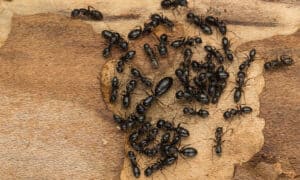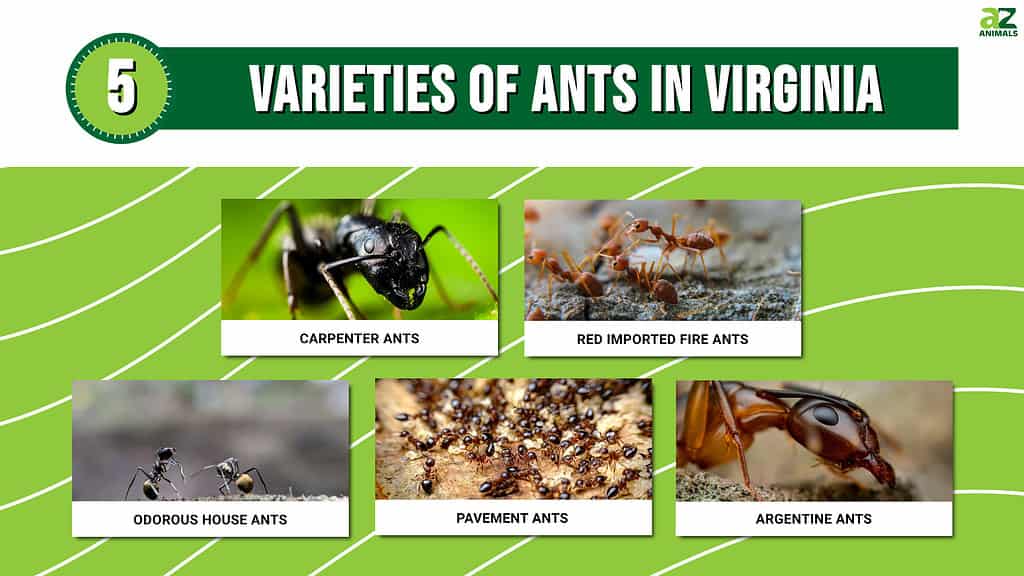
Ants are a familiar part of life in the United States. In every state, you will find at least one variety of this small invertebrate, and there are over 12,000 different types of them worldwide. In Virginia, there are 79 species of ants. As summer approaches rapidly, you’re more likely to see these long-living insects, and it’s important to know a little bit about them before they spoil your picnic or tunnel through your home. First, we’re going to give you a brief summary of what they are, and then we’ll dive into a list of just a few of the ants you can expect to see if you live in or are visiting the beautiful state of Virginia.
What are Ants?
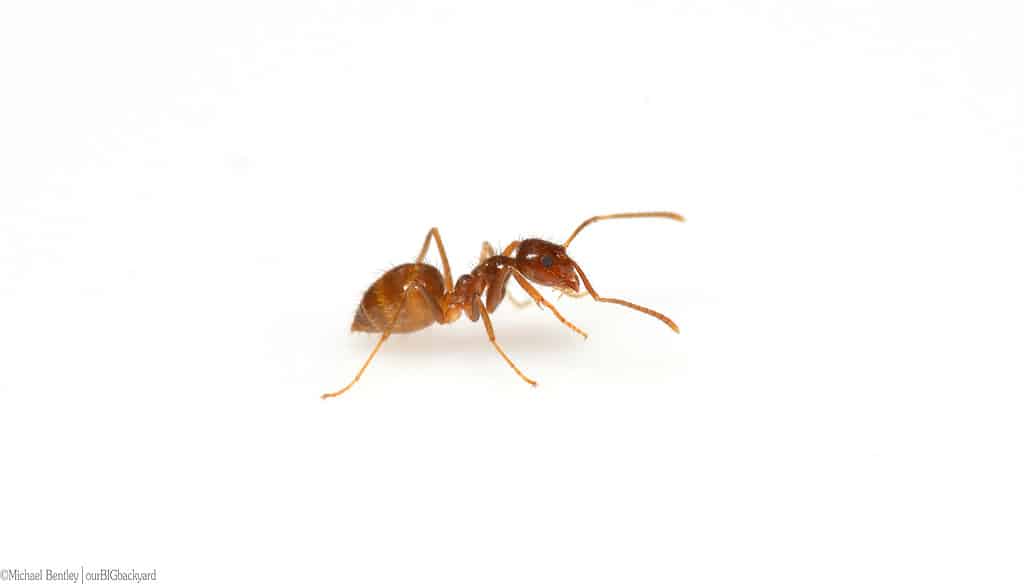
There are 79 species of ants in Virginia.
©Bentleypkt / CC BY-SA 4.0 – License
Ants are small invertebrates that inhabit every continent except for Antarctica. They evolved from their wasp ancestors over 100 million years ago, and they are one of the oldest species of insects alive today. They also have impressive lifespans, which vary based on species, sex, and status in the colony. Queens are capable of living for multiple decades, while many males only live a few weeks.
These insects are eusocial, which means they have highly-structured social organizations. These social structures are matriarchal and revolve around the queen, who is the founder of the colony, and the layer of eggs. She is the only ant in a colony capable of reproducing, and colonies without a queen eventually die. Worker ants are all female but unable to reproduce.
They take on the responsibility of labor – from raising the brood to foraging for food. Male ants play the smallest role in any ant colony, but it is an integral one. Males reach adulthood quickly – within a matter of weeks – and their mission is singular: breed. After fulfilling their reproductive duty, they die, leaving behind a legacy of survival for an entire species.
Fun Facts About Ants:
- Ants communicate using pheromones – chemicals the body produces and excretes to trigger social responses in other ants.
- Ants have two sets of jaws – one for chewing and one for digging and carrying.
- These insects will communicate by sharing food mouth-to-mouth in a process called Trophallaxis.
- Ants don’t have ears and cannot hear, and sense sound by vibration instead.
- There are an estimated 20 quadrillion ants in the world.
- The largest ant colony in the world spans over 3,700 miles!
1. Carpenter Ants (Camponotus pennsylvanicus)
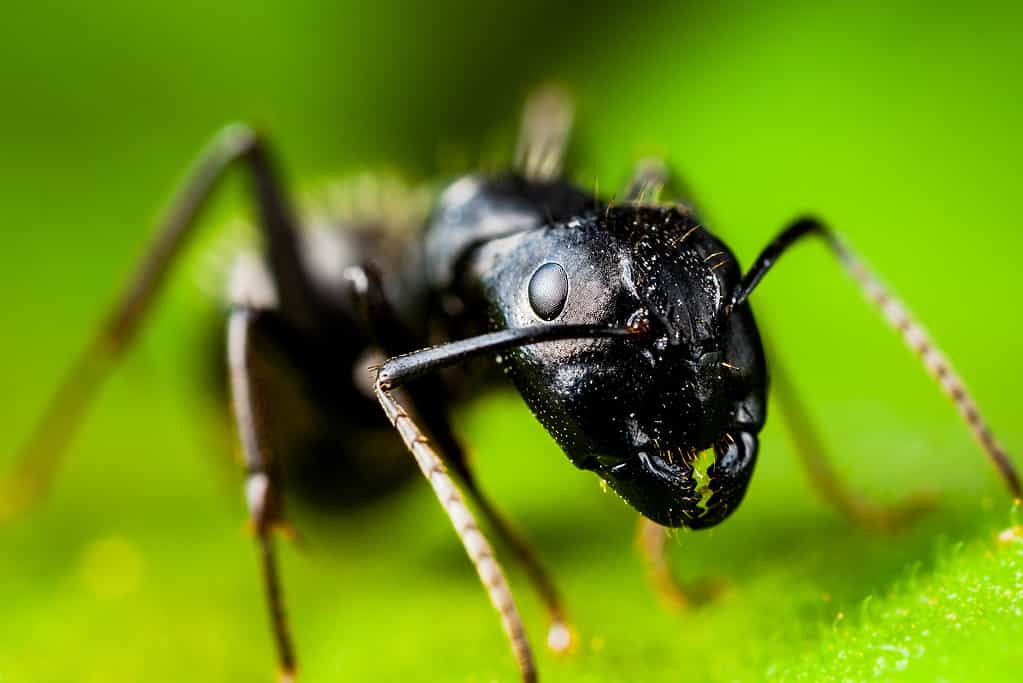
Contrary to popular belief, carpenter ants don’t eat wood. They just tunnel through it to make nests!
©Denis Vesely/Shutterstock.com
We’ll start with the largest species of ant that invades households in Virginia. Carpenter ants are infamous for their wood-tunneling habits that leave many homeowners in fear of structural damage. These ants usually build their main nest – the parent nest – outdoors. They construct the nest around decaying wood such as dying and fallen trees, old firewood piles, and tree stumps. Inside homes, ants build parent nests in compromised wood, such as areas damaged by water – around tubs, sinks, and dishwashers, under roofing, and in already hollow areas. Satellite nests are secondary nests in dry locations. They house worker ants, pupae, and mature larvae. Worker ants build satellite nests inside insulation, hollow doors, and wall voids.
Carpenter ants are black or black and red and they become active in the spring. Their busy season lasts from as early as March to at late as October, and they are present in large quantities through the summer. You are most likely to see these ants swarming at night – as dusk falls, worker ants leave the nest in search of food.
2. Red Imported Fire Ants (Solenopsis invicta)

Cargo boats from South America accidentally carried this invasive species to the United States.
©NOTE OMG/Shutterstock.com
Red imported fire ants are a growing problem across the southern United States. In Virginia, residents complain of ever-increasing swarms of this invasive variety of ants. The insects are dark red and appear furry due to the small hairs that cover their bodies. The Virginia Department of Agriculture has imposed a fire ant quarantine across 12 separate counties and 11 cities.
Their name is appropriate to their worst feature – a painful, burning sting. This sting is part of a two-pronged attack. Biting first, they attach themselves to the skin with their outer jaw to get a good grip. After, they curl their abdomen forward and deliver several powerful stings. A sting from one of these ants isn’t just irritating, it can have lasting impacts. Swarms of fire ants are capable of killing small and newborn animals with their venom. You should avoid fire ants if possible, and treat stings quickly to avoid further irritation.
Similar to most other varieties, red imported fire ants swarm in the summer, creating discomfort and fear for most Virginia residents. You will see more swarms after summer rainfall – especially after an extended dry period. Their presence dissipates in autumn when cooler days and crisp nights drive them deeper into warm soil.
3. Odorous House Ants (Tapinoma sessile)
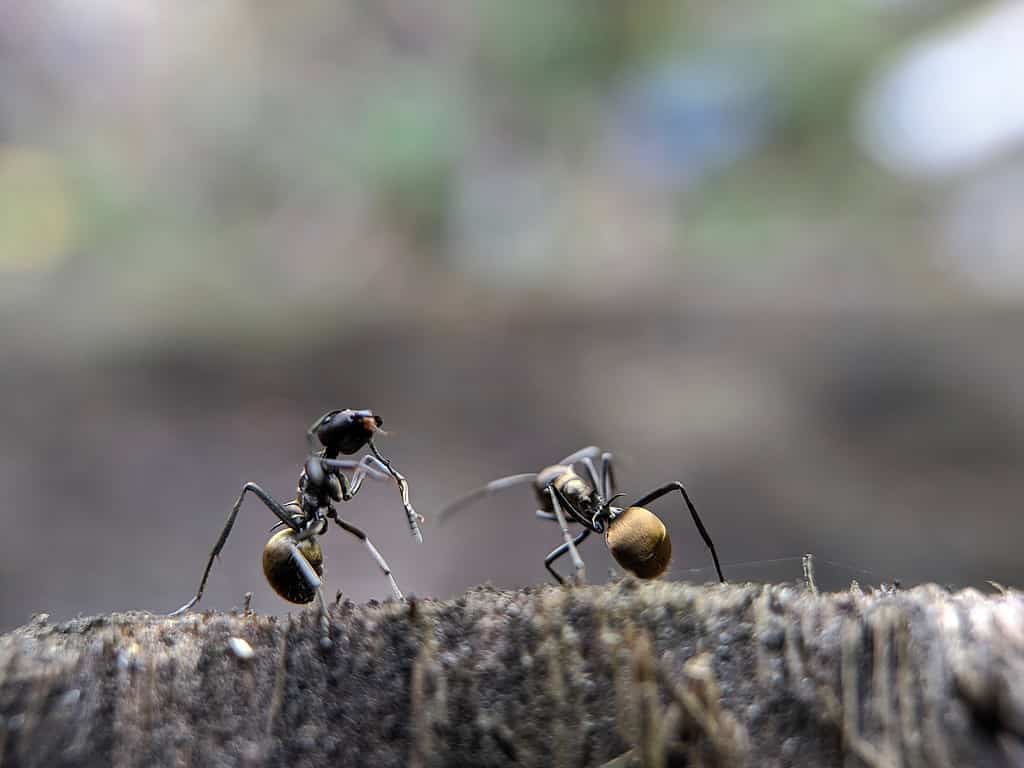
Odorous house ants are stinky – their smell is similar to bleu cheese or rotten coconut!
©Dhe Tong/Shutterstock.com
You’ll easily be able to identify odorous house ants by the smell they give off. The smelly little insect is black or dark brown and enjoys the indoors. The little opportunists will nest anywhere there are suitable resources, including in your home. They are most likely to invade your home during wet or rainy weather, and they make their nests inside wall panels beneath floors and carpets.
They are present all year round in warm climates, but they swarm in the summer. Are you spotting a trend? Many invertebrates need warm weather in order to survive, and summers are ideal for them due to temperature and food supply. You are most likely to see them in large numbers in June and July.
4. Pavement Ants (Tetramorium immigrans)

Pavement ants get their names from their nesting habits – you’ll see them scurrying out of cracks in the sidewalk!
©Ezume Images/Shutterstock.com
Small and reddish-brown, the pavement ant is another pest in Virginia. They love sweet and greasy foods and build their nests as close to food sources as possible. This means you will see their nests by garbage cans and near or inside your home. They’re docile and non-aggressive, and they now live in all 50 states. These insects thrive in human-made environments – they are the most common variety that occurs as a household pest. They have a short-lived swarming season in high summer, and they are notorious for existing year-round in warm, indoor climates.
They are territorial toward other colonies – pavement battles during swarms often result in the appearance of several dead bodies along the sidewalk. Their other common name, sugar ant, refers to their food source of choice.
5. Argentine Ants (Linepithema humile)
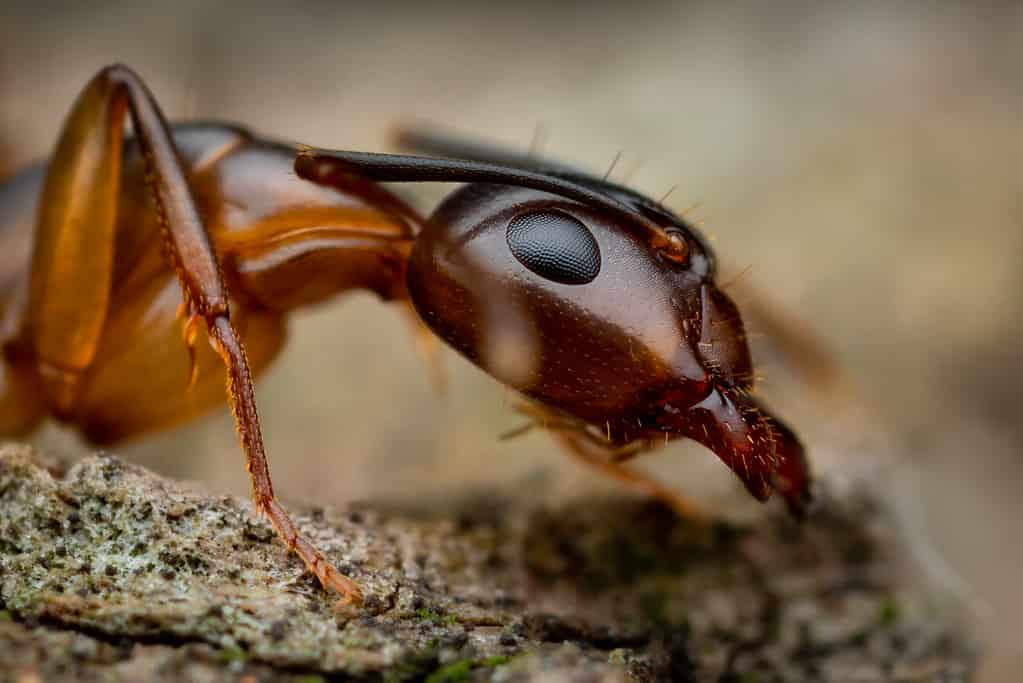
Another aptly-named insect – Argentine ants originate from Argentina and other countries in South America.
©Javier Chiavone/Shutterstock.com
Last on our list is another invasive species, this one particularly threatening to native vertebrates, arthropods, and plants. This is another opportunistic species that will nest anywhere it can, especially since it isn’t as good at digging as other ants. In nature, it makes its home under small stones or in piles of loose leaves. In urban areas, it invades crevices in homes, like cracks in concrete or between walls. It will also take over old nests of other ants, which gives it a chance to establish itself more securely and create a larger problem.
Argentine ants are small and dull brown in color, and their colonies are extensive and contain multiple queens. The queens of these colonies often forage alongside the workers, but that’s not all that makes this species unique. There is no aggression between neighboring colonies, and they often merge to create ‘super-colonies’. Further, they do not swarm – breeding happens inside the nest. You’re still more likely to spot them in the summer months, as temperatures rise above 75 degrees Fahrenheit. They are least active in winter and almost never seen in November-January.
This particular species is one of the 100 worst invasive species in the world, according to the Global Invasive Species Database.
How to Prevent Infestations
The first line of defense against these invasive critters is prevention. Make sure to seal and put away food around your home, and clean up spills as soon as possible. Even breadcrumbs in toaster trays and granules of sugar left in cupboards are enough to attract colonies to your door. Clean up after you find and kill them, as well – they follow the pheromone trail of other members of their colony and will enter your home just because another one already has.
Properly seal your home. Compromises in the pavement around your house and the wood in your house raise your risk of infestation.
When you see one or more of these little pests in your house, be sure to do your research or ask an expert when trying to identify them, as prevention and eradication methods vary based on species type. One way to identify the variety and nesting place of these insects is to follow them from their food source back to their nest. Knowing the location of nests helps you control the population and better discern the species you’re dealing with.
Prevention is the best line of defense, but it isn’t always enough. You can work to eliminate colonies in a variety of ways, including the use of insecticides. Be very careful when researching and employing elimination methods – insecticides are effective but carry potential risks for children, pets, and the local ecosystem. Also, keep in mind that it takes a long time to eradicate established colonies. In order to keep the problem under control, you will have to work diligently and patiently. In the end, extermination is not a guarantee. There are more of them than there are of us, and a future free of ants is highly unlikely.
Other Insects Set to Emerge in Virginia
Summer is insect season, which means ants aren’t the only insect to look out for! Here’s a short list of the many different bugs that will be out and about as temperatures in Virginia soar.
Summary
Now that we’ve covered 5 varieties of ants in Virginia, it is important to remind you that there are 74 more species that occur in the state. There are also over 20,000 other varieties of insects that call Virginia their home, many of them preparing to emerge as summer begins.
| Common Name | Native or Invasive to Virginia | Interesting Fact |
|---|---|---|
| 1. Carpenter Ant | Native | Tunnels through decaying wood to make its nest |
| 2. Red Imported Fire Ant | Invasive | Bites and stings, and can kill small animals in a swarm. |
| 3. Odorous House Ant | Native | Smells like rotting coconut when crushed. |
| 4. Pavement Ant | Invasive | Engages in deadly battles with other colonies of the same species. |
| 5. Argentine Ant | Invasive | Creates ‘super-colonies’, and is the species that forms the largest ant colony in the world. |
The photo featured at the top of this post is © iStock.com/DianaLynne
Thank you for reading! Have some feedback for us? Contact the AZ Animals editorial team.




